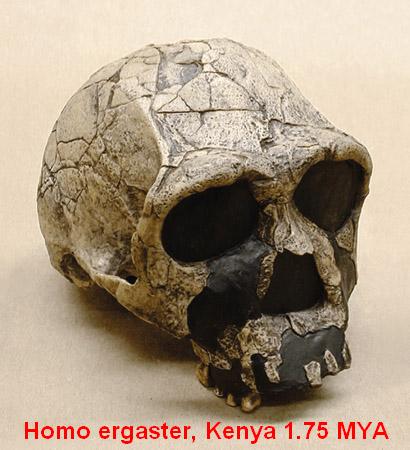
This is Homo ergaster, a species very similar to the Homo habilis we just discussed last chapter. Claims vary as to the age of this supposed ancestor of modern Man, estimates ranging from it being anywhere from 1.9 to 1.5 million years old. Of course, regarding the specimen ages, we may as well just flip our coin again, as we have seen already the tendency of scientists to change the dating of these specimens by tens, and sometimes hundreds of thousands of years. Either, then, ergaster thrived for a 400,000 year period, or the guesses as to its antiquity are that far off. We should assume the latter, as we have very few fossils and so little evidence, certainly not enough to accept this species as a descendant of Man at all, never mind as thriving for 400 millenia.
“Homo ergaster” means “working man”, a name it has been given because of the possibility that it used stone tools. In its characteristics ergaster looks at times a lot like habilis, but other representative fossils look very different and so it sometimes is considered a sub-species of Homo erectus, our next subject. This indecision is likely due again to problems classifying the fossils found. As we will see, the remains cited for ergaster could actually be from different sorts of creatures, or possibly could be of real men. A look at the fossil record is then imperative. This will take a bit of time.
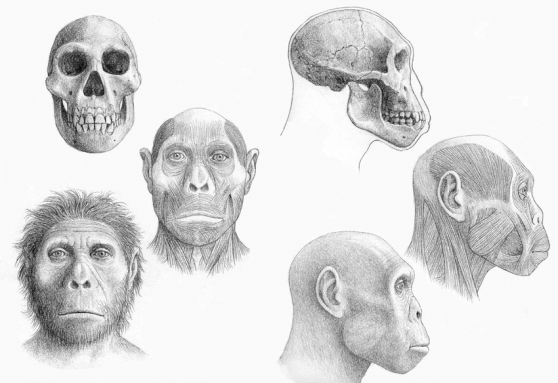
There are supposedly remains from 20 individuals of this line, I count 22. Immediately one will notice that many of the same fossils attributed to Homo habilis, or Handy Man, are also attributed to this Homo ergaster, or Working Man. This boosts the fossil number count considerably.
Let’s then sort out this situation. The following fossils we have already discussed, and are attributed variously to either Handy Man or Working Man, or both:
1. SK-847
2. KNMER-731
3. KNMER-992
4. KNMER-1808
If you follow the fossil numbers we cited last post, and compare them to the ones I will cite presently, you will see that sequential numbers do not always indicate that they came from the same creature. This happens when fossils from a dig are discovered in sequence, labeled in that order of discovery, and then later reallocated to a different species, or rejected as insignificant or of known origin. This is another shady aspect of fossil handling, that is, the tendency to variously assign these discovered bones even where no corroborating evidence exists. The accuracy probability is low, indeed.
Some of these discovered pieces, it should be mentioned, have even been “officially” classified now as erectus specimens! Well, just because they eliminate the “man” does not mean they have to waste “good fossils”, after all, the Leakeys and associates have already been paid…
Regardless, let’s look at the remaining fossils that claim to be evidence of anything like a “Working Man”. The pertinent remains were all dug up either near Dmanisi in Georgia, a reconstruction of that skull shown in the pencil sketch above, from Koobi Fora in Kenya, and at, once again, the Olduvai Gorge in Tanzania. We learn the Leakey Enterprises Inc. is also responsible for these “discoveries”.
First, let’s take a look at the evidence from that anthropological gold mine, the famous Olduvai Gorge:
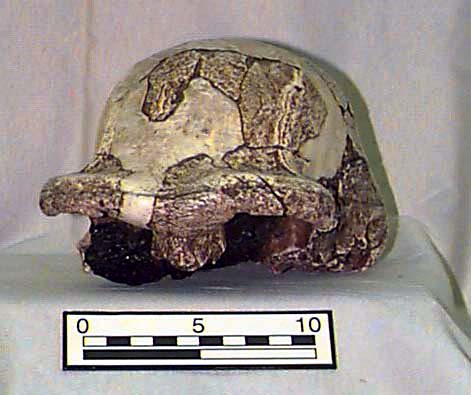
There she is, the entire proof of this species from the Olduvai Gorge. As has been the usual procedure, bits and pieces are put together, molded, sculpted, and joined with Bondo, or some filler (in beige), to give us this German army helmet specimen. Just try to locate the “before” photos, on the internet, in the library, from museums, etc., and expect to encounter great difficulty. If a picture is worth a thousand words, let’s take this “evidence” as another product of certain “scientists” scurrying to show some fruit for their “labors” – and expenses incurred – and move on to, we hope, more certain evidence that Working Man ever existed as a human ancestor.
Similarly, the comparatively recently-discovered evidence from Dmanisi (1999) is also small and questionable. What we have from there are two craniums that came in lots of pieces, as usual with the caveat “assembly required”. Luckily we have photographs of the evidence from Georgia:
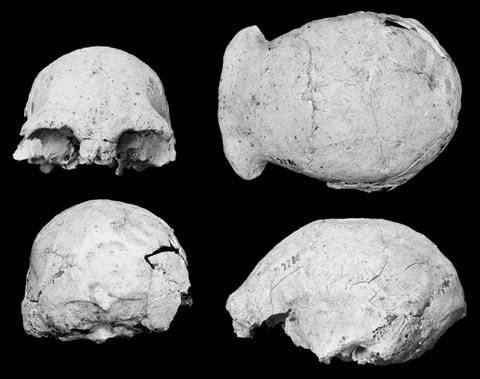
This above is the reassembled d-2280, below, d-2282. One has to wonder, and so ask our persistent question: Where are the rest of this tribe? And for that matter what happened to d-2281?
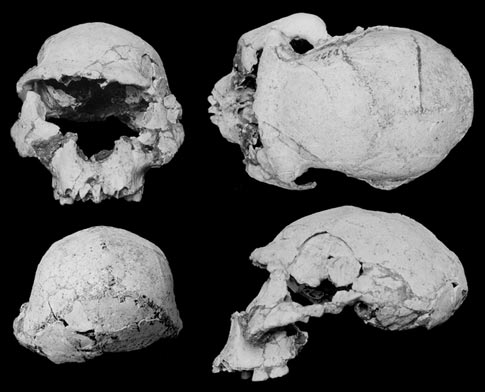
This find is a bit unusual because it hails from one of the few places we have discussed so far that does not still have a thriving and prominent ape, monkey, chimp, or other simian population. Try to find a source for the historical distribution of all simians and you will find the road difficult to travel. This is because, as you know, humans are classified as hominid in the same way as are the chimpanzee and baboon. This, we should make careful note of again, is a huge scientific error of classification. As we have said, simply because species look similar (and I am still fascinated by, and find difficulty looking away from, the simians whether live, in pictures, on TV, or in movies…they are fascinating creatures to observe) does not make them the same. Bats and birds, e.g.
Without much doubt I consider the Georgian Man, Homo georgicus, to be an archaic gibbon, or something like a gibbon. I have made a collage to illustrate this, immediately below this paragraph. There are two views of georgicus on the left, two of a gibbon on the right; you should know that I could use different gibbon skull samples to get even closer to the actual appearance of georgicus:
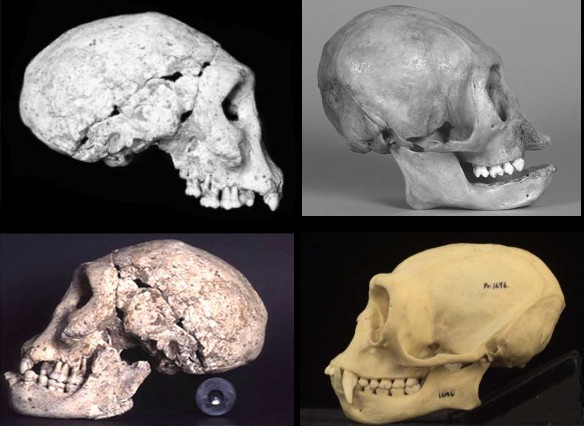
Every good taxonomist knows that shared characteristics are not themselves indicative of special difference. What do we make of the porpoise, for instance? It is by all scientific claims as intelligent, if not more advanced that the monkey. Some dogs and horses are more intelligent than monkeys as well, depending on how you consider the ability to be “trained” a sign of intelligence. A porpoise or dolphin looks nothing like land creatures which share the same basic cardiovascular system and it looks very similar to a fish, which we know it very much is not. We are right to be as curious about chimps as we are about porpoises, wrong to think we are no more advanced than they are. To create, and to deviate from instinct, are examples of distinctly human behavior. We will discuss human ingenuity further later, after we finish trying to understand the scientific, meaning of course the Theory of Evolution explanation for the origin of Man.
So we continue again back to Homo ergaster, as the band Rush would say, “they call him the Working Man”. These remains, as we said, are interesting, and it makes us want to look seriously at what may be different between these discoveries and the rest of the specimens we have discussed previously. I’ve put together another little collage to show a comparison, accepting for its sake that the fossil fragments have been honestly and accurately assembled:
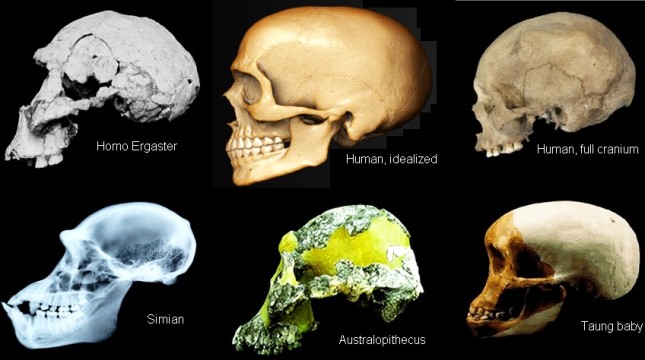
Please note these are not to accurate scale. Working Man, Homo ergaster top left in these samples, shares most characteristics with the australopithecines and the Lucy. The distance from the nasal cavity to the upper jaw and teeth is too long, the brow ridge is too profound, and the assembly of the jaws and ridges along the side of the head too arbitrarily reconstructed for it to be definitive Homo Sapiens remains. Pieces that definitely have been forced together are apparent. This is significant because if assembled one way it can be seen as more human, in another way, more simian.
Also par for our current course, Evolutionists and Creationists alike continue to debate with each other, and even amongst themselves, as to what this thing is, some of both claiming ape as I am here, others, as early human. Here below is another picture of this specimen which shows the ape character of Homo georgicus:
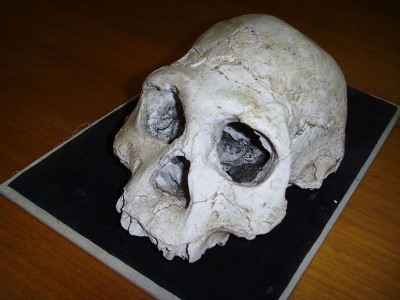
The only problem here for a positive simian designation for this creature is the lack of apes in current Georgia. The fact that more recently legs of this species have been discovered does not aid the argument for this creature’s humanity, and it appears those limbs are more indicative of an australopithecine. May we say, the legs found were forced to fit the skull already in our possession? What proves the relation of the parts? We definitely need to look at the discoveries from the other places, to see more evidence.
All we have left are the fossils from Kenya, almost all found by the Leakeys and their collaborators.
KNMER 3734 (1), 3889 (2) and 3892 (3) are insignificant and probably pieces of humans, or at least, Homo erectus. I have yet to find photos of their evidence, but they’re being cataloged everywhere and spoken of as if their classification is problematic.
Here are the rest of the not-so important fossils:
(5) KNMER 730 jaw or mandible fragments (M. G. Leakey 1970)
“Traits correlate [it] with both ergaster on one hand, and erectus on the other”.
(6) KNMER 731 mandible fragments
(7) KNMER 819 mandible fragment
“Although placed in the general classification of Homo, is also a candidate for boisei. Because of its greater robusticity, it is placed [with] ergaster instead of habilis”.
(8) KNMER 820 juvenile tooth
“…compared closely to the erectus specimen from Zhoukoudian. This specimen is placed by many under the H. erectus classification”.
(9) KNMER 992 partial mandible (C. Groves and V. Mazakin 1975)
“Dated to 1.5 million years. KNM-ER 992 is the type specimen for Homo ergaster“.
(10) KNMER 1466 left Side of cranium
“Thick and rather robust features could also place this specimen with H. erectus or even as a robust H. sapiens”.
(11) KNMER 1478 cranial fragments
“Highly eroded, this piece has proved to be hard to identify, yet has been place[d] under the genus Homo”.
(12) KNMER 1593 are skull fragments
(13) KNMER 1648 is a parietal fragment
(14) KNMER 1808 are skull fragments
(15) KNMER 1811 are mandible fragments
(16) KNMER 1812 are mandible fragments
(17) KNMER 1821 is a right parietal fragment
(18) KNMER 2592 are left parietal fragments
(19) KNMER 2595 is a right parietal fragment
(20) KNMER 2598 is an occipital fragment
From looking at the evidence you can see why what is ape, what is human, and what could in-between, is a matter of much debate. While we have seen already the extent of disagreement about the classification of nearly all the ancient remains we have discussed so far, no other “pre-human” fossils have more divided both Evolutionists and Creationists alike than ergaster.
To be fair, this indecision about classification should probably be expected for any “missing link” and it is possibly true that, as far as missing links go, this Working Man, if any at all, is probably the one. But, as we have also seen time and again, there are here also many insurmountable problems with the evidence, some scientists speculating that many years ago apes did roam the areas inland of the Black Sea not being the least of them. Some theorists have even made the claim that apes, and possibly even humans, originated in Asia and not in Africa as is Science’s current teaching. This also lends some credence to a monkey migration, and provides a testament to the long-standing existence of the simians. The apes have been around for quite a while.
If we refuse to accept these specimens as anything like a proof of Evolution’s theory about the origin of Man, if we say that they are just more apes, then there are two more important finds that we need to consider carefully before we jump the gun and discard out of hand all this mumbo-jumbo about any Working Man. Yes mumbo-jumbo, you know, the expected-to-be taken seriously “scientific” talk about things like what these creatures did when they woke up in the morning, how quickly and how big they grew, how fast they could run, their biting power, etc. It gets really deep…the farther out we go.

A Note On Truth And Nonsense
While I love to stand and bask in the waters, I swim only when necessary. I am always leery about the depths, and the accompanying darkness when entering the deeper waters, where I can feel no solid foundation. I try to, as often as possible, keep myself grounded somehow. Similarly, I need to ground myself, in the hunt for the origin of Man, and the base that makes me comfortable is (objective) Truth.
Some believe objective Truth – that is, something true for all times, and for everyone – does not exist, and by virtue of some form of relativism will argue against my claim that it does. They will argue that even objectivity is an illusion, when in reality true objectivity, I insist, is the perfection of subjectivity, and is the proper aim of honest inquiry. While it has been treated often that way throughout history, this Truth need not be mystical, or limited to flashes of enlightenment, at all. That there are words on the computer screen (or printed page) you are reading right now, for instance is for me an objective truth, or Truth with a capital T. Whether you think what is being said is true or not, or whether you even pay attention to the words you read, are completely different questions, nevertheless even both of these latter assume the Truth of the former. To refute any position, or defend it, you must first recognize it. To argue further on this issue, perhaps insisting that these words are not really words, or saying that what is on the computer screen or book is just a representation of words, would make any further discussion impossible. The conversation would degenerate to meaningless babble.

Truth is about certainty, while Science is about probability. By Truth then I mean only something that is evidently true, or which follows from certain conditions. Prejudices aside, biases and affiliations aside, the instruction of our parents aside…all those noises must be tuned out in order to try and hear Truth.
In the classic, major sense, Truth is that “wisdom,” (greek sophia) or “knowledge” (episteme) which is beyond doubt. Its analogy is mathematics, where in that system 2+2=4, and there are 180 degrees in a triangle. It was the same search for certainty that later led Descartes to declare the cogito, or the “I exist” as the first Truth of this kind, debate over which declaration continues to this day. Part of the problem, it seems, regarding the Evolution versus Creation debate, is the Evolutionary discarding of Truth along with surety and anything like God. As for the Creationists, they are part of the trouble in that they demand more surety from Science that, ideally, it is supposed to impart. Properly Science only suggests, with honesty in experimentation and reporting, what might be the Truth, and it never goes beyond probability, and never accepts evidence as valid until other confirmations are obtained.
There exists a plethora of theoretical science surrounding Evolution, but let us say that most we have looked at is not worth an objective damn. Here we are, almost to modern human beings, in our quest for Evolution’s answer for the origin of Man, and all we have been shown as evidence for our efforts are archaic chimps, apes, monkeys, and bones given ages so varied science ought to be ashamed of its lack of internal investigation into its accepted tools and methods. We have so far found no Truth in these regards.
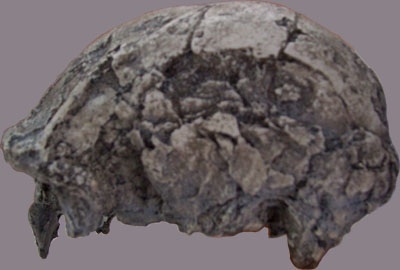
Turkana Boy
But I promised more evidence of Homo ergaster, who after all is supposed to be our subject this chapter. As I say fossils from two individuals remain for us to discuss. One is KNMER-3883, which I consider of little value. There is left then one most important discovery, and that is the Homo ergastus specimen known as “Turkana Boy“, the famous 1984 discovery led by Leakey Inc.
Turkana Boy is variously assigned to Homo ergaster or Homo erectus, and this is relevant, not in that it proves yet again the problems with classification regarding these things, but also because the consensus for the Working Man is that it is likely a Homo erectus. I would say Turkana Boy has a better chance of being Homo antecessor, actually, and probably should be classified as such. Nevertheless, it is said that he was between 10 to 13 years old when he died.
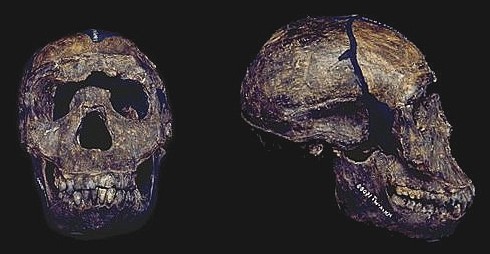
Imagine how some serious scientist could write a paper with a thesis that Turkana Boy’s apparent extra vertebra can be explained as a vestigial organ and reason for back pain!
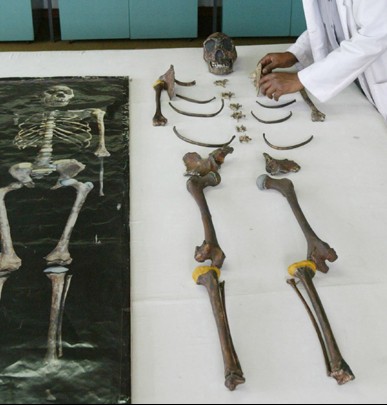
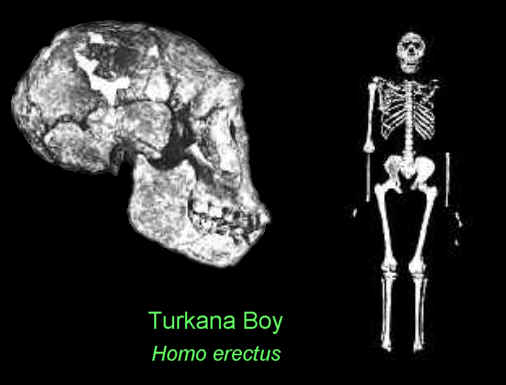
It’s impressive appearance, as in these photos, and the apparent strength of the leg bones, do not offset the primitive aspects of the reconstructed skull, put together from over 300 pieces. The close up of the face makes me want to go against Creationists and Evolutionists alike here, and call Turkana Boy yet another primate.
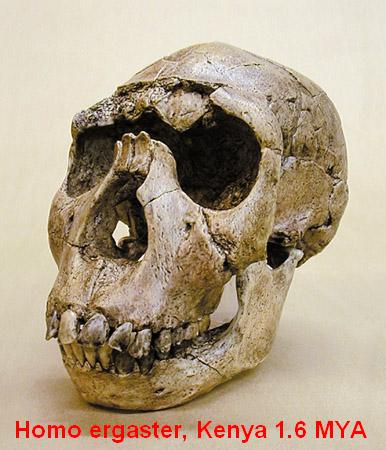
Notice how this Turkana Boy skull differs from the other ergasters we have been considering. Here now is some example of the speculation, or I should say creative writing or propaganda, concluded about this fragmentary skeleton, which could also be made up of parts of several different individuals. I will put in bold type all the questionable conjecture:
The boy was about ten years old at death – because of his more rapid maturation, comparable to a modern lad’s early-to-mid teens. At about five foot four he was tall for his age, of linear build, long-limbed and strongly muscled. He contrasts with hominids such as Australopithecus and H. habilis, who were shorter overall, deep-chested and pot-bellied, with short legs and long, powerfully muscled arms suggesting appreciable arboreal activity. Turkana Boy’s pelvis and leg anatomy are essentially modern, pointing to striding bipedalism with no hint of climbing adaptations, so indicating a fully terrestrial niche… [source here]
Not one of those highlighted claims can be proven true.
My gut feeling also is that this individual is mis-matched, meaning Turkana boy’s head is on someone else’s body parts. There are no feet, the actual fossils show varied degrees of wear, and the reconstruction has been extensive. One almost gets the impression this creature was concocted simply to keep the Evolutionary spirit alive. Here is a better photo of the parts before their being glued together, wired together, and put on display:
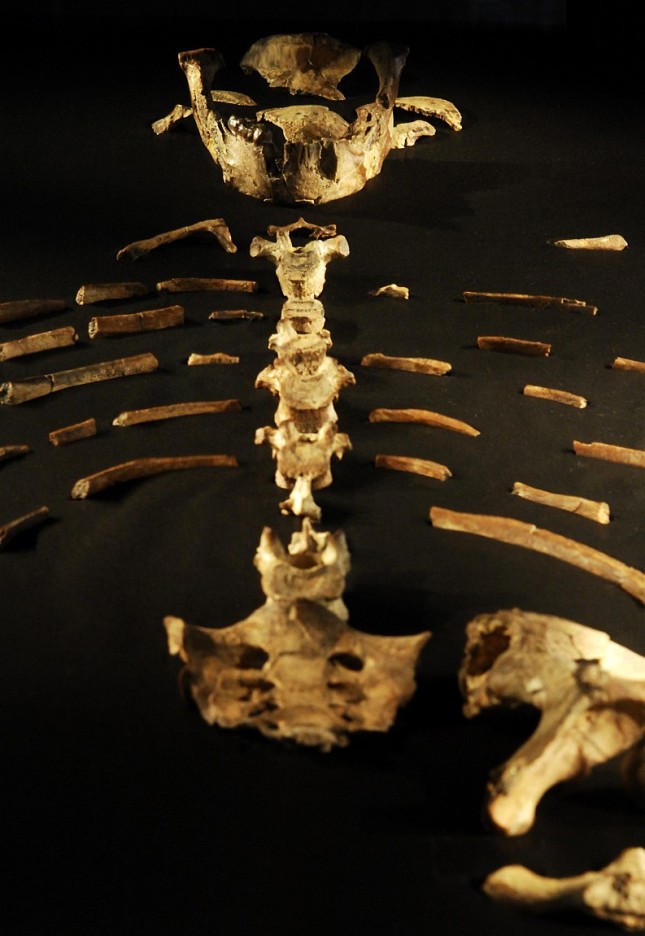
It is just not enough. Two or three more, from the same area, more complete, and we might have something here. I would entertain further evidence supporting the claim that this creature is human. But for me this isolated fractional skeleton just does not provide enough proof, even added to the rest we have examined, for any existence of a Working Man human ancestor.
I will close with the reconstructions of Turkana Boy, and some other Working Man Homo ergaster reconstructions. Next time, we continue our survey, and we examine whether the next in the going vertical line, Homo erectus, is the first real Homo at all.
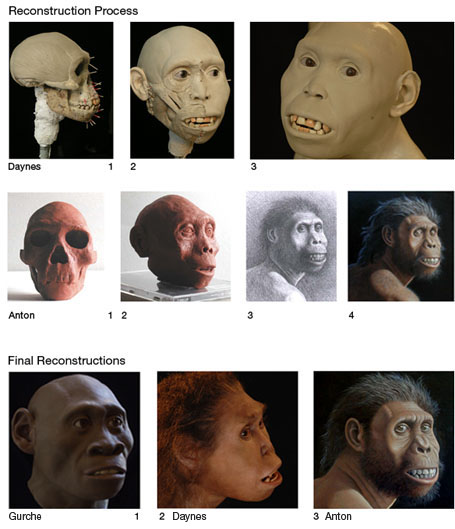
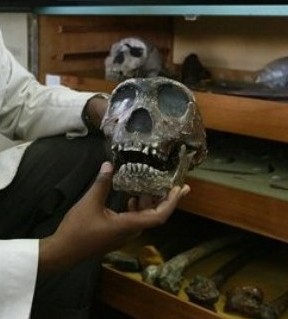
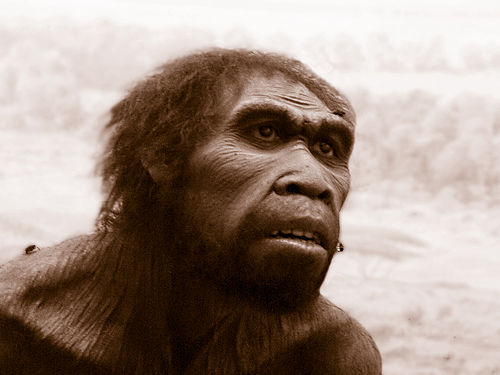

A satirist could surely have a field day:
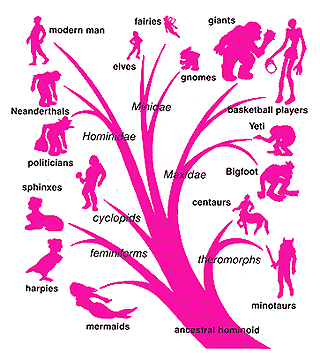
-Edited 2-2019
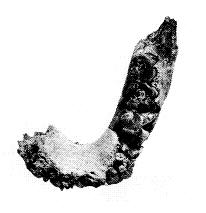
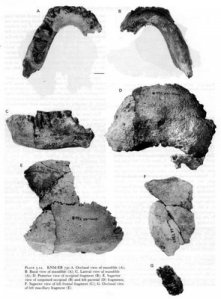
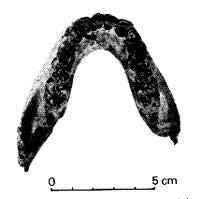
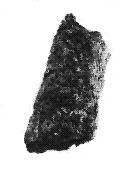
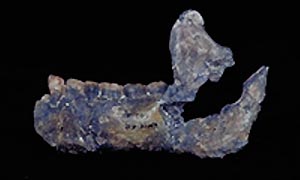
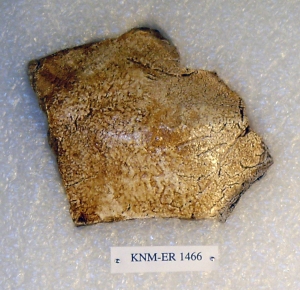
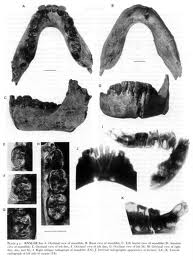
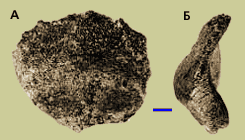




Lanskee Shuru
November 5, 2012 at 11:26 pm
When did Homo Stupidus take over for good?
URSheep
November 21, 2012 at 4:07 pm
About the time of Darwin
Rein Teder
February 11, 2014 at 4:42 pm
I had no idea how sparse the actual fossil record for supposed ancestors of man truly is.
The one exception might be Turkana boy. The body really does look more or less human, and the head more or an less ape. I could see tremendous pressure on the Leakeys to put something together from whatever bones they could find.
But, you ultimately conclude this is an ape. Would you please elaborate?
Truthopia
April 27, 2014 at 10:04 am
Apes in general look more or less human, do they not? When you can piece together several different specimens, of different ages, sizes, perhaps even eras, and join them to form one individual, the odds increase you can produce a more “human-looking” conglomeration. I could, for instance, create for you the skeleton of a unicorn, if I can borrow the horn of an ibex 100 miles away and say it belongs with the horse skeleton we found just around the corner.